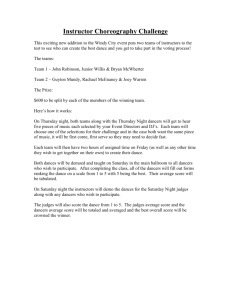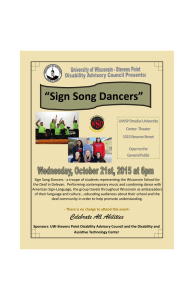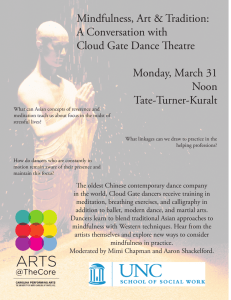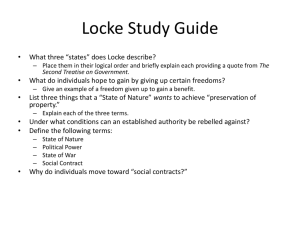Gahu
advertisement
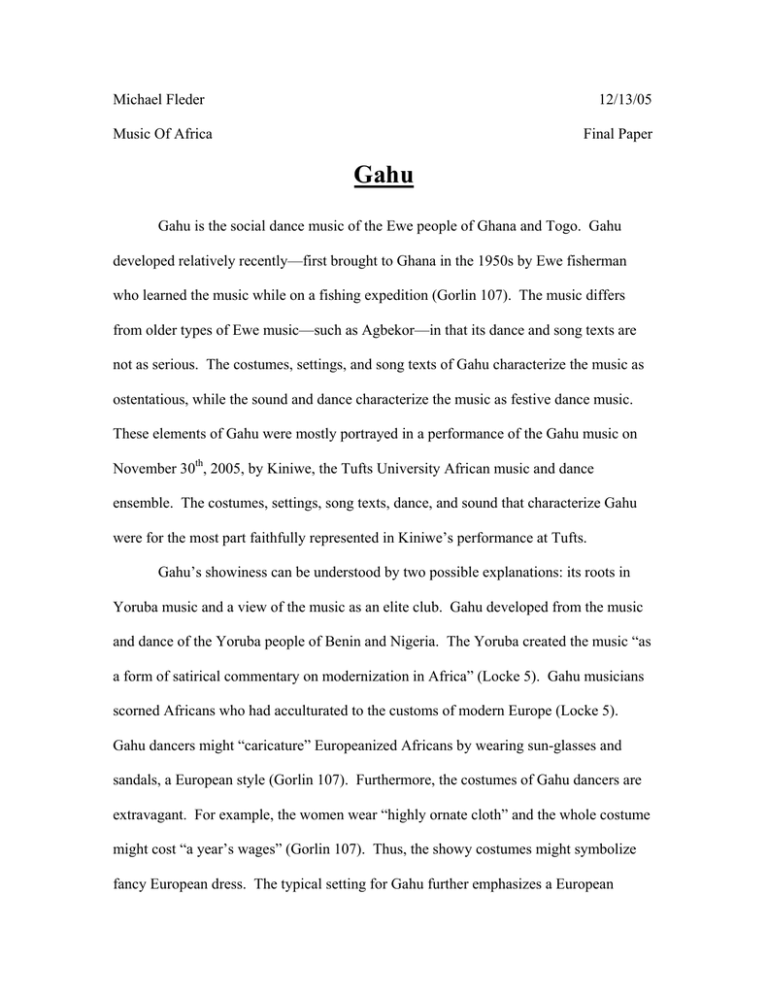
Michael Fleder 12/13/05 Music Of Africa Final Paper Gahu Gahu is the social dance music of the Ewe people of Ghana and Togo. Gahu developed relatively recently—first brought to Ghana in the 1950s by Ewe fisherman who learned the music while on a fishing expedition (Gorlin 107). The music differs from older types of Ewe music—such as Agbekor—in that its dance and song texts are not as serious. The costumes, settings, and song texts of Gahu characterize the music as ostentatious, while the sound and dance characterize the music as festive dance music. These elements of Gahu were mostly portrayed in a performance of the Gahu music on November 30th, 2005, by Kiniwe, the Tufts University African music and dance ensemble. The costumes, settings, song texts, dance, and sound that characterize Gahu were for the most part faithfully represented in Kiniwe’s performance at Tufts. Gahu’s showiness can be understood by two possible explanations: its roots in Yoruba music and a view of the music as an elite club. Gahu developed from the music and dance of the Yoruba people of Benin and Nigeria. The Yoruba created the music “as a form of satirical commentary on modernization in Africa” (Locke 5). Gahu musicians scorned Africans who had acculturated to the customs of modern Europe (Locke 5). Gahu dancers might “caricature” Europeanized Africans by wearing sun-glasses and sandals, a European style (Gorlin 107). Furthermore, the costumes of Gahu dancers are extravagant. For example, the women wear “highly ornate cloth” and the whole costume might cost “a year’s wages” (Gorlin 107). Thus, the showy costumes might symbolize fancy European dress. The typical setting for Gahu further emphasizes a European influence: Ghanaian performance groups often perform Gahu in a European-style concert setting, where the audience observes the performance with little participation. Furthermore, the name Gahu can be translated as ‘airplane,’ a symbol for European “modernism” (Locke 5). Thus, Gahu may serve as a sort of satirical commentary on Europeanized Africans. Other elements of Gahu, however, suggest that its showiness comes from the music’s exclusivity: Gahu can be viewed as an “exclusive club which attracts those seeking recognition as people of wealth and substance” (Gorlin 107). For example, the expensive price of an outfit prevents those without money from participating. Indeed, the name Gahu can also be translated as “money music” (Gorlin 107). The song texts further illustrate the exclusiveness of the Gahu group. For example, the song Mi dze todeme includes the line, “those who are capable of Gahu are the people of substance” (Gorlin (111). Other Gahu songs like Minya Kpo na and Sei adzo yi are in this style of praising those who participate in Gahu as a select group (Kiniwe Song List). The performance context of Gahu may also suggest exclusivity. Gahu groups often perform at life cycle rituals; but Locke notes that these performances are only for rituals of Gahu group members, their relatives, or dignitaries (Locke 6). Thus, life cycle performances of Gahu are in some sense restricted to the Gahu group, thus contributing to Gahu’s exclusive nature. Although Gahu may be flashy, the sound retains elements that are characteristic of other types of African music: polyrhythm, call and response, and vocables corresponding to the rhythms. The polyrhythmic nature of the music comes from the interlocking parts of many instruments. If the part of each instrument is taken in Fleder 2 isolation, the music might seem somewhat simple, but together, “the drums, bells, and rattles form a unified whole” that creates an intricate, polyrhythmic “drum conversation” (Hartigan 58). This “drum conversation” is emphasized by the call and response between the instruments. For example, Locke labels the gboba “THE CALL,” because it initiates the call and response (Locke 69). And he regards the sogo and kidi as “THE RESPONSE” because they respond to the gboba’s call (Locke 37). The gankogui, atoke, axatse, and kaganu parts are “THE TIME,” and together, THE CALL, THE RESPONSE, and THE TIME create a polyrhythmic interplay (Locke 16). By examining the instruments and their associated rhythms within this interplay, one finds a meaningful drum language. The instruments in a typical Gahu ensemble are gankogui—an iron double bell; axatse—a gourd rattle; and the drums kaganu, kidi, sogo, and gboba. Ensembles may also include an atoke bell and atsimevu, a large drum. There is a correspondence between the names of the drums and the rhythms they play. For example, the kaganu plays an offbeat sixteenth note rhythm that corresponds to the vocables “ka-ga” (Locke 31). Similarly, the kidi plays a rhythm that corresponds to the vocables “kid-di-gi-di” (Locke 47). Ewe drummers regard these vocables as a drum language: “[singing a] story on the drum” (Locke 7). To emphasize their importance, Locke writes the vocables under the corresponding notes in his transcriptions. Thus, a drum language, call and response, and a polyrhythmic whole characterize the sound of Gahu. The music and the dance of Gahu are closely intertwined. The lead drum directs the dancers, and the combination of music and dance creates an atmosphere of fun and enjoyment (Leake 5). The dancers move counterclockwise in a circle of alternating men Fleder 3 and women; their performance includes “long passages of a lightly bouncy basic ‘step’ leavened with brief ‘get down’ sections in which the dancers lower their center of weight and move with intensified strength and quickness” (Locke 7-8). The lead drummer signals the dancers to change their movements through his playing (Locke 69). The transitions between dance steps consist of the dancers throwing their arms in the air and shouting. The dance reflects the festive nature of the music. For example, the song text for “Kinini Tana” includes the line “Get down and enjoy yourself; do your own thing” (Hartigan 59). The “get down” sections are characterized by hip and shoulder shaking and reflect the energetic playing of the drummers. The dance, sound, song texts, and costumes of Gahu were mostly portrayed in Kiniwe’s performance at Tufts. Kiniwe’s dress differed significantly from that of a typical Gahu group; but Kiniwe’s sound, dance, song texts, and performance venue were very close to that of a typical Gahu group. For example, the Kiniwe dancers wore colorful skirts; but whereas Ghanaian dancers might have worn skirts made of intricately woven kente cloth (Leake 1), the Kiniwe dancers’ skirts were made of rather plain cloth. Furthermore, the drummers wore plain black pants—a very minimal dress. In addition, the performers wore white t-shirts that said “Kiniwe” on them—clearly not a fancy dress style. The discrepancy between the expected and actual dress styles might be accounted for by the fact that the group’s repertoire included non-Gahu material, such as Agbekor and Agbadza, for which the dress styles are different. Regardless, the Kiniwe outfits lacked the fanciness normally associated with Gahu. Despite their surprisingly plain outfits, Kiniwe played and danced Gahu mostly as one might expect to see it performed in Ghana. For example, the recordings of Mimo Fleder 4 Suka monu, Mi dze todeme, and So kple abena me ka di o (Gorlin CD) are accompanied by only gankogui and axatse, while a leader and a group engage in call and response singing. These songs segue into pieces accompanied by the entire drum ensemble. Similarly, Kiniwe began with a medley of songs including the piece Gahudo gbele gbele za tsi ee. These songs featured David Locke playing the gankogui while leading a call and response with the dancers—drum accompaniment was not included. After the opening medley, Kiniwe played two more pieces that included all of the Gahu instruments. The pieces were played in 2/4 with the typical gankogui bell line; the drums also played the expected rhythms. Thus, the instrumentation throughout Kiniwe’s performance reflected that of the archetypal Gahu group heard on the Gorlin CD. Although Kiniwe’s first piece did not include dancing, the subsequent pieces featured typical Gahu dancing. For example, during the second piece the dancers moved counterclockwise in a circle with light steps. When the gboba played a rhythmic “call,” the dancers would lift their arms in the air and yell “whoa.” They would then proceed into the “get down” section in which they moved their hips and shoulders very vigorously. After the get-down section, the dancers again shouted “whoa” and continued moving in a circle as before. The dancers then added variation to their original dance steps by performing a shoulder dip movement; next they repeated the previous transitions into and out of the get-down section. The song eventually moved into a Kinka section, another type of Ewe music. The Kinka section featured the performers dancing in pairs. Since Kinka is often included in the repertoire of a Gahu group (Gorlin 108), its inclusion in Kiniwe’s performance was not unexpected. After The Kinka section, the piece moved back into Gahu but with increased intensity. The song concluded with the dancers Fleder 5 singing a phrase before falling to the floor. The last Gahu piece was also danced in a traditional style but with the audience dancing as well. The dancers and audience formed three circles that moved counterclockwise. The audience and performers seemed to greatly enjoy dancing; indeed, Gahu is a fun dance music. Thus, Kiniwe’s dancing matched that of a typical Gahu group. Although the Kiniwe’s dance closely reflected that of a typical Gahu group, Kiniwe’s performance was somewhat Americanized. For example, before the second piece, the dancers arranged themselves in a circle by using a count off: one dancer would say “one,” the next “two” and so forth. Much of the audience laughed during this count off, because the dancers were superimposing an American positioning technique on a foreign dance. Furthermore, when the audience participated during the third song, a number young children in the audience wandered around a-rhythmically to the music—a participation style that one would not expect at a Gahu performance. While Kiniwe’s dance performance varied slightly from that of typical Gahu groups, the ensemble’s song texts were in fact traditional Gahu songs. For example, the group performed Gahudo gbele gbele za tsi ee, a song which can be heard on the Leake CD. The group’s other song texts embodied characteristics that are typical of Gahu songs. For example, Kiniwe sang Minya kpo na, which can be translated as: We are looking good. Gahu group, we are looking good. We have gorgeous outfits that we are wearing, And shoes too. Something happened at Keta town (Kiniwe Song List). Like many Gahu songs, Minya kpo na clearly praises the Gahu group and boasts of its possessions. Kiniwe also performed Sei adzo yi, which explicitly praises the Gahu group: Fleder 6 “Praises to the Gahu group” (Kiniwe Song List). Thus, Kiniwe’s song repertoire reflected that of a typical Gahu performance group. The setting of Kiniwe’s performance also fit the nature of the Gahu music but in a very unexpected way. The group performed in the Aidekman Arts Center at Tufts University. The room was flat with no stage; a large wooden dance floor occupied most of the space. The dancers performed on the dance floor while the drummers sat just behind it. Chairs for the audience encircled the dance floor. This setup is not uncommon in European or American performance spaces, and since Gahu groups often perform in such theaters, the afore-mentioned part of the setting could be expected at the performance of a Gahu group. The most interesting parts of the setting, however, were the fancy chandeliers hanging from the ceiling, the paintings of scholars graduating from the university on the walls, and the pianos that occupied two corners of the room. These last elements are not necessarily characteristic of a Gahu performance setting but complemented the music nevertheless. For example, Gahu songs, such as Minya kpo na often boast of the group’s possessions and suggest an atmosphere of elegance. The intricate chandeliers hanging from the ceiling indeed created such an ambiance. Furthermore, Gahu performances may be interpreted as a satire of Europeanized Africans and thus often include elements such as the dancers wearing sunglasses. The performance of Gahu in a room with pianos and paintings of Western scholars on the walls indeed suggested such a commentary on Westernization in Africa; the pianos and paintings are as incongruous with traditional African music as sunglasses on the face of a Gahu dancer. The performance of music that satires Europeanized Africans in a room with European elements highlights the Fleder 7 lampooning nature of the music. Thus, although many elements of the setting at the Aidekman Arts Center were typical of a Gahu performance, other characteristics of the performance space fit the music in an unexpected way. Kiniwe’s performance and descriptions by ethnomusicologists indicate that Gahu is lively, enjoyable dance music. Although Kiniwe’s performance might be interpreted as commentary on Europeanized Africans, I doubt that any members of the audience were aware of that aspect of the music’s significance. The audience consisted mostly of friends of the musicians and dancers, who wanted to see an “African music and dance” performance (Tufts Website) —a very generic label for the event and one that does not attribute Gahu’s unique cultural meaning to the performance. Locke notes, however, that “the meaning and significance of Gahu has become a function of the process of its reenactment” (Locke 6). Thus, Gahu may be perceived as satirical music, an exclusive, boasting music, good time dance music, or as simply an embodiment of African music and dance, depending on its performance context. Fleder 8 Bibliography Gorlin, Dan. Songs of West Africa. Forest Knolls, CA: Alokli West African Dance, 2000. Gorlin, Dan, Ed. Songs of West Africa accompanying CD. Forest Knolls, CA: Alokli West African Dance, 2000. Hartigan, Royal. West African Rhythms for Drumset. Miami: Manhattan Music Inc, 1995. Jones, A. M. Studies in African Music. London: Oxford University Press, 1959. Leake, Jerry. Ewe Drumming of West Africa: An ensemble/lab presented by Jerry Leake. I attended one class of an Ewe drumming lab taught by Jerry Leake at the New England Conservatory in Boston (October 2005). He provided both a booklet and a CD of Gahu examples. Leake, Jerry. Ed. Ewe Drumming of West Africa CD. Locke, David. Drum Gahu. Crown Point, IN: White Cliffs Media, Co., 1987. Locke, David. Ed. Kiniwe Song List: Gahu Songs as Taught by David Locke. Teaching materials. After the Tufts concert, I asked David Locke about the content of Kiniwe’s songs, and he provided me with the song list that the group uses. This song list includes both the song texts and their translations. Nketia, J. H Kwabena. African Music in Ghana. Great Britain: Northwestern University Press, 1963. Tufts Life Campus Calendar. November 30th, 2005. http://www.tuftslife.com/calendar/ Fleder 9
